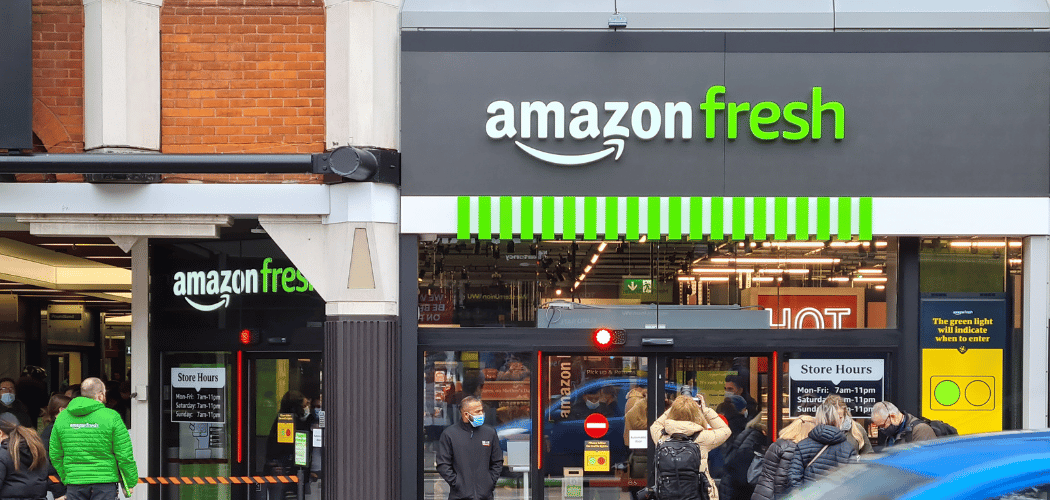Amazon is now inviting non-Prime subscribers to purchase groceries from its online Fresh store. They’ll have to pay a little more for deliveries, and can’t yet order from Whole Foods, but it does extend a once exclusive, paid-for perk to anyone. Does Amazon risk watering down the value of its $139 annual memberships?
By Jenn McMillen
How many $4 fees add up to a $139 privilege? Amazon is about to find out.
The online retailer and owner of Whole Foods and other physical stores has extended access to its Fresh grocery deliveries to non-Prime members, the Verge reports (citing Bloomberg). Before the change, Amazon grocery delivery had been limited exclusively to Prime members, who pay $139 a year for the privilege.
The initiative is available in just a dozen cities, although Amazon plans to expand it countrywide by the end of 2023. It also applies only to orders from Amazon Fresh, not Whole Foods, but that too may change.
Here’s the thing: The key perk that now distinguishes Amazon Fresh for Prime members, versus Amazon Fresh for all, is a $4 savings. The Fresh delivery fee for non-Primers is $7.95 to $13.95, depending on the size of the order. For members, it’s $3.95 to $9.95. (Prime members get free delivery on orders of more than $150.)
Still, that “pay wall” may be a little thin for Prime members whose primary reason for subscribing is access to perks such as Fresh, with its competitive prices and fast delivery. It doesn’t help that Amazon in February more than quadrupled the minimum order amount for guaranteed free deliveries of Fresh to $150, from $35.
That fourfold-plus hike likely put a bad taste in many members’ mouths, especially coming one year after Amazon raised its Prime membership fees by 17%, to $139 from $119.
Unpack The Finances – A Fresh Revenue Stream
Offering Amazon Fresh grocery delivery service to the millions of people who do not subscribe to Prime opens a new revenue source for Amazon. Is it worth the risk of irking its nearly 150 million U.S. Prime members? Possibly.
Amazon has shuttered many stores in the past couple of years. In 2022, it closed all of its Amazon Books, Amazon 4-Star and Amazon Pop-Up locations. In early 2023, it closed eight convenience stores and announced it would pull back on its Fresh store expansion until it finds a format that “resonates with customers,” the Verge reported.
Closed stores mean lost sales; underperforming stores typically mean lost profits.
By offering grocery delivery to non-Prime members, Amazon might have found an alternative to these closed outlets that is much more affordable (read: profitable). And if the extended Fresh generates enough revenue, it might prevent Amazon from raising its Prime fees any time soon.
That would be a positive move if members feel their paid-for perks are no longer exclusive.
Learning From Member History
Yet, based on history, Amazon should prepare for at least some member blowback. The price of membership, to many, includes preferential treatment. When non-subscribers have access to the same perks, those perks lose value and worse, the paying members might perceive it as unfair.
After all, we all have a natural inclination to compare ourselves to others. When members see others receiving the same perks they pay for, it threatens their perception of status. Preferential treatment, to many paying members, is justice.
There are other, tactical reasons not to give away certain perks, as well. Among them:
No exclusive customer insights. Loyalty programs assign unique identifiers to members, which follow their preference history to inform better marketing, merchandising and even store layouts. Inviting non-members to use member-only benefits could reduce that return on investment. Case in point: Several loyalty program operators extended member benefits to non-members as a business-preservation measure during the Covid pandemic. But once those benefits went away, many non-members did as well. Because those short-term customers never registered for the loyalty programs, they weren’t trackable, so the programs gained no instructive insights. Essentially the companies gave the goods away for free and irked long-time loyalty members in the process.
It can compromise service times. Nearly one in six consumers said they purchased groceries online every week in 2022, according to Pymnts. Let’s theorize that half of those consumers, one in 12, had their groceries delivered by Amazon. If millions of new households take advantage of Amazon Fresh delivery, that demand could put the quality and timing of the delivery service at risk. Alert Prime members who expect preferential treatment will be more sensitive to such glitches. Amazon, meanwhile, is focusing on raising the bar: In April, Amazon CEO Andy Jassy told analysts the company is on track in 2023 to achieve its fastest Prime delivery speeds ever. That’s a lot of pressure.
It can make the competition look better. Amazon’s announcement to extend Fresh grocery delivery to non-members might cause Prime members to look into the options of other retailers, and compare. Walmart+, for example, offers free delivery on order minimums of just $35. Many Prime members may have resisted the Walmart+ deal because Amazon includes so many other benefits, including video streaming, but that difference in delivery price is tight: Walmart+ members pay $6.99 for deliveries of less than $35. Amazon Prime members pay $9.95 on Fresh orders of less than $50, according to Winsight Grocery Business. And Walmart+ also includes streaming.
Loyalty Means Never Having To Say, ‘You’re Equal’
Loyalty operators are likely familiar with an important report that came out in the Harvard Business Review years ago, which challenged the efficacy of loyalty programs. Among its points, the report advised that the benefits of loyalty programs can only be realized when a company “admits not all customers are equal.”
“A company that offers average-value products and services to everyone wastes resources in over-satisfying less profitable customers while under-satisfying the more valuable loyal customers. The outcome is predictable. Highly profitable customers with higher expectations and more attractive choices defect, and less desirable customers stay around, diluting the company’s profits.”
In the case of Amazon Fresh, non-members generate $4 more per delivery than Prime members – $208 a year if ordering weekly. The difference between that sum and Amazon’s annual membership fee of $139 can be narrow. Or not, if Amazon sends reminders directly to its many Prime members spelling out all of their other benefits, including gaming and others perks they might not know about.
It should do so fast, like in two days or less. Because even when paying for their privileges, loyalty member expect those privileges to make them feel more special than the rest.
This article originally appeared in Forbes.
Forbes.com retail contributor Jenn McMillen is nationally renowned as the architect of GameStop’s PowerUp Rewards, and is Founder and Chief Accelerant of Incendio, a firm that builds and fixes marketing, consumer engagement, loyalty and CRM programs. Incendio provides a nimble, flexible and technology-agnostic approach without the big-agency cost structure and is a trusted partner of some of the biggest brands in the U.S.



